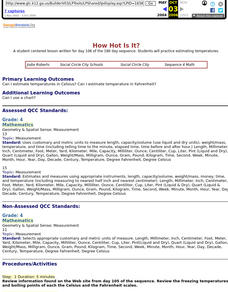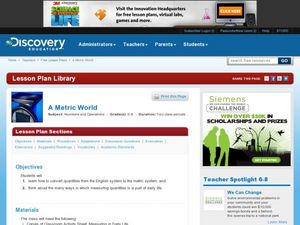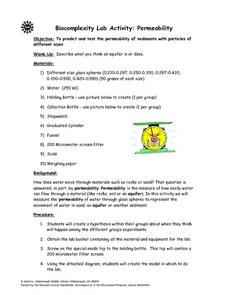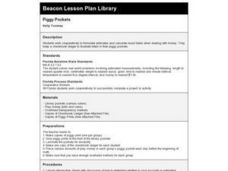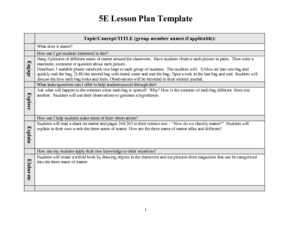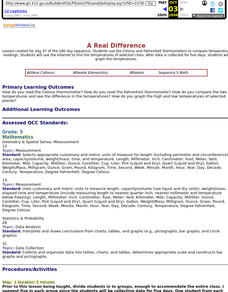Curated OER
Kinetic Energy and Work
High schoolers study kinetic energy and how it works. In this investigative activity students divide into groups and attempt to break a board with their hand.
Curated OER
How Hot Is It?
Fourth graders practice estimating temperatures. They practice in Celsius and Fahrenheit.
Curated OER
Using the Hunter Model and the Holistic Model
Students increase their knowledge of scientific processes in chemistry. They compare and analyze 3 sets of data, they have gathered, for accuracy and precision.
Curated OER
LEGO Balance
Students design and build a balance using LEGO, string, and a set of standard metric weights.
Curated OER
A Metric World
Students convert English to metric units. In this math lesson, students give examples of measurements they encounter in their daily lives. The share their answers in class.
Curated OER
Waste Audit
Students engage in a lesson that is concerned with the concept of mental math. They perform calculations as following: recognizing a half, three quarters, and tenths. Students are also challenged to extend skills to making calculation...
Curated OER
Biocomplexity Lab Activity: Permeability
Learners identify how water moves through materials such as rocks or sand. Students measure the permeability of water through glass spheres to represent the movement of water in sand, an aquifer, or another sediment. During the...
Curated OER
Piggy Pockets
Second graders determine when estimates and exact totals are appropriate in dealing with money. They simulate keeping a checking account over a period of time and keep a checkbook ledger to record deposits and expenses.
Curated OER
You say Avocado, I say Avogadro
Young scholars convert mole to mass to particles and vice versa. In this chemistry lesson, students discuss the importance of Avogadro's number. They apply what they have learned in a team competition.
Curated OER
Accurately Weighing Pennies I
Drawing from a scenario of the history of the penny, learners write and solve a system of linear equations from a context.
Curated OER
Accurately Weighing Pennies II
Drawing from a scenario of the history of the penny, learners write and solve a system of linear equations from a context.
Curated OER
Tick Around the Clock
Students examine and discuss the differences between clocks they are shown. Using the internet, they research how people used to tell time before clocks. They review what the long and short hand on the clock represent and practice...
Curated OER
Lake Effect
Fourth graders explore some of the effects Great Salt Lake has on Utah's local weather/temperature moderation, lake effect storms, and temperature inversions. They observe the differences of specific heat between soil and water and...
Curated OER
More Volume Please! Don't Be Dense!
Fifth graders determine volume and density through their knowledge of mass, volume and density.
Curated OER
The Home Stretch
Students read the novel Stone Fox by John Reynold Gardiner. Using Lego RCX units, students build and program sleds to re-enact the "home stretch" of the National Dog Sled Race.
Curated OER
Bell Curve
Students construct two bell curves using two different yet related objects. For example, two kinds of Hershey's Kisses (plain and almond) or two kinds of dried beans (kidney and lima).
Curated OER
What Does It Matter?
Students match definitions with vocabulary words and learn basic facts about matter. Then, they see how to determine the physical characteristics of matter. They determine the mass, volume, and density of objects using appropriate tools...
Curated OER
What Does It Matter?
Students define matter, the chemical properties of matter, and the physical properties of matter. They name physical and chemical properties of matter (by classifying using a Tree Map). Students determine the mass, volume, and density of...
Curated OER
The Grouchy Ladybug
Students complete a Cirlce Map about time. They recall times during the grouchy ladybugs travels, and add dots on ladybugs using turn-around facts. Pupils correctly sequence the events of The Grouchy Ladybug. Students compose new...
Curated OER
Acids, Copper, and Zinc
Students observe chemical reactions using post-1982 pennies. They observe the reaction of an acid with zinc but not copper under the same conditions over a two week period.
Curated OER
A Real Difference
Fifth graders use the Celsius and Fahrenheit thermometers to compare temperature readings. They use the Internet to find the temperatures of selected cities. After data is collected for five days, 5th graders graph the temperatures.
Curated OER
Nature of Game Balls
Fourth graders see how, when balls are dropped from the same height, mass and size affects the motion of the balls.
Better Lesson
Better Lesson: Math Trash
A lesson where students collect trash, sort, and record the mass in grams. They will use their knowledge of numbers to figure out what category of trash had the most. The biggest idea of the lesson is that students will be more likely to...

